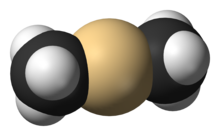


| |
| Identifiers | |
|---|---|
3D model (JSmol) |
|
| ChEBI | |
| ChemSpider | |
| ECHA InfoCard | 100.007.324 |
| EC Number |
|
PubChem CID |
|
| UNII | |
CompTox Dashboard (EPA) |
|
| |
| |
| Properties | |
| C2H6Cd | |
| Molar mass | 142.484 g·mol−1 |
| Appearance | Colorless liquid |
| Odor | Foul; unpleasant; metallic; disagreeable; characteristic |
| Density | 1.985 g/mL |
| Melting point | −4.5 °C (23.9 °F; 268.6 K) |
| Boiling point | 106 °C (223 °F; 379 K) |
| Reacts with water | |
| Hazards | |
| Occupational safety and health (OHS/OSH): | |
Main hazards |
Extremely toxic, reacts with water to release methane |
| GHS labelling: | |
  
| |
| Danger | |
| H225, H250, H252, H260, H301, H330, H350, H360 | |
| P101, P102, P103, P222, P231, P301+P310, P303+P361+P353, P305+P351+P338, P403+P233, P422, P501 | |
| NFPA 704 (fire diamond) | |
| Flash point | 18 °C (64 °F; 291 K) |
| Related compounds | |
Related compounds |
|
Except where otherwise noted, data are given for materials in their standard state (at 25 °C [77 °F], 100 kPa).
| |
Dimethylcadmium is the organocadmium compound with the formula Cd(CH3)2. It is a colorless, highly toxic liquid that fumes in air. It is a linear molecule with C-Cd bond lengths of 213 pm.[1] The compound finds limited use as a reagent in organic synthesis and in metalorganic chemical vapor deposition (MOCVD). It has also been used in the synthesis of cadmium selenide nanoparticles, although efforts have been made to replace it in this capacity due to its toxicity.[2]
Dimethylcadmium is prepared by treating cadmium dihalides with methyl Grignard reagentsormethyllithium.[3]
The same method was used in the first preparation of this compound.[4]
Dimethylcadmium is a weak Lewis acid, forming a labile adduct with diethyl ether. A yellow, air-sensitive adduct is formed with 2,2'-bipyridine.[3]
|
| |
|---|---|
| Animal toxins |
|
| Bacterial |
|
| Cyanotoxins |
|
| Plant toxins |
|
| Mycotoxins |
|
| Pesticides |
|
| Nerve agents |
|
| Bicyclic phosphates |
|
| Cholinergic neurotoxins |
|
| Other |
|